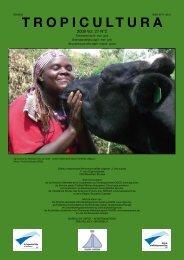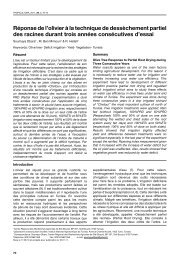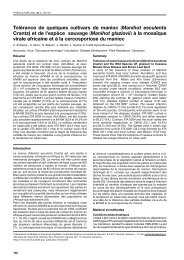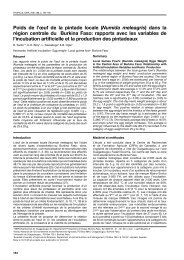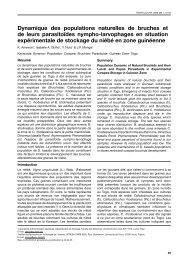Fascicule entier - Tropicultura
Fascicule entier - Tropicultura
Fascicule entier - Tropicultura
Create successful ePaper yourself
Turn your PDF publications into a flip-book with our unique Google optimized e-Paper software.
haricot et le pourcentage des graines trouées étaient<br />
respectivement de 32-122 contre 126-2920 (témoin);<br />
1,3-8,8% contre 23,4-71,08% (témoin) et de 1,8-29,8%<br />
contre 19,9-89,9% (témoin). Les poudres végétales<br />
étaient plus appréciées par les paysans par rapport<br />
aux feuilles des plantes. Dans le futur, d’autres essais<br />
Introduction<br />
In the Democratic Republic of Congo as in other<br />
countries of Eastern, Central and Southern Africa,<br />
bean (Phaseolus vulgaris L.) is an important food and<br />
cash crop and the most important food legume (6,<br />
12, 13). In these Sub-Sahara African countries, beans<br />
cover more than 22% and 10% of communities’ daily<br />
needs of proteins and energy respectively (6, 7). In<br />
eastern of DRC (Kivu provinces particularly), beans<br />
are a primary source of vegetable protein and an<br />
essential supplement to roots and tuber-based diets<br />
(7, 10). Beans are mostly grown by 90% of smallholder<br />
farmers in Kivu provinces. Yields vary considerably<br />
in different agro-ecological zones of the provinces:<br />
from 500 to 4000 kg/ha. Farmers grow both bush<br />
and climbing beans as sole or in intercropping with<br />
sorghum, maize, bananas and cassava. Climbing<br />
beans are more present in high altitude than in low<br />
and medium altitude areas (5, 6, 8, 10). It is a common<br />
practice in that region to conserve bean grains after<br />
harvesting, waiting for moments of good prices at local<br />
and regional markets. Therefore, beans are stored for<br />
a period of three to nine months in traditional stores.<br />
However, bean storage over long periods, especially<br />
at small-scale subsistence farming levels in Kivu (D.<br />
R. Congo), is limited due to bruchid infestation that<br />
results in heavy losses about 35-95% (6, 8, 10). To<br />
avoid excessive losses, most farmers are forced to<br />
sell off surplus grain immediately after harvest, and<br />
this; unfortunately, often coincides with the time when<br />
prices are lowest. This scenario reduces motivation<br />
to increase production as well as to store for longer<br />
periods and hence contributes to develop the vicious<br />
cycle of low dietary intake of cheap proteins of high<br />
biological value.<br />
Conditions are usually inadequate at farmer level to<br />
prevent or reduce insect attacks during storages.<br />
In earlier works, bean bruchids (Acanthosclelides<br />
obtectus, Coleoptera: Bruchidae) were identified as<br />
main pest of beans in storage (9). Generally, in Kivu<br />
provinces, bruchid infestations start in field and<br />
continue in storage (Munyuli, personal observation).<br />
There is still a paucity of information on appropriate<br />
field and storage management methods of bruchids<br />
at small-scale farmers’ level in eastern and central<br />
Africa.<br />
Available bruchids management methods in storages<br />
TROPICULTURA<br />
sont nécessaires afin d’évaluer le risque pour la santé<br />
humaine lié à la manipulation des poudres végétales aux<br />
doses efficaces lors de la lutte contre les bruches. La<br />
répétition des essais avec des doses plus faibles serait<br />
intéressante à réaliser puisque la dose efficace apparaît<br />
trop élevée pour être économique ou rationnelle.<br />
include use of vegetable oil, hermetic storage,<br />
solarisation, sunning, sieving regimes and contact<br />
insecticides and fumigants.<br />
Across Sub-Sahara Africa bean growing regions,<br />
there are increasing efforts to develop cheaper and<br />
sustainable insecticide-based local techniques for<br />
protecting seeds in small traditional farm stores<br />
(Dr K. Ampofo, personal communication). Some of<br />
these methods (sunning, ash,…) were evaluated by<br />
scientists for their effectiveness in controlling bean<br />
bruchids (17, 21). The use of plant products is popular<br />
in Kivu provinces. Small-scale farmers in Kivu usually<br />
mix stored foodstuffs with different kinds of plant<br />
products to protect them against bruchid damages.<br />
A modest survey of ethnobotanical materials used<br />
traditionally for stored products protection in Kivu,<br />
was conducted by Munyuli (9), with the objective of<br />
evaluating their active constituents.<br />
A checklist of botanicals used by farmers for the<br />
control of bean bruchids was thereafter established<br />
(9, 10). The performance of effective botanicals was<br />
also earlier tested in the laboratory (10). Findings<br />
from these laboratory trials showed that the mixture<br />
of several (around 12) botanicals (insecticide and<br />
repellents plant species) during the formulation of<br />
doses is effective rather than using powders from<br />
one or three plant species (11). The repellency of that<br />
powder can be maintained in stores for more than 6<br />
months unlikely for powder from a single plant species.<br />
The performance of a single plant species do not go<br />
over than 3 months in store: generally, bruchid attacks<br />
are observed from the first month of storage. Farmers<br />
in Kivu provinces are mostly interested in storing their<br />
beans as seeds in order to meet needs and wants of<br />
seeds in further cropping campaigns. During cropping<br />
campaigns, there is a growing willingness of all bean<br />
producers to buy seeds of good quality from their<br />
neighbors. Farmers are also interested in delaying<br />
sales, waiting for the improvement of the market (8).<br />
To be efficient, these activities require that bean be<br />
stored for at least 6 months. The mixture of several<br />
plant species during powders manufacturing, appears<br />
meeting farmers’ needs.<br />
There was a need to validate and disseminate<br />
promising technologies under farmer field and storage<br />
175



